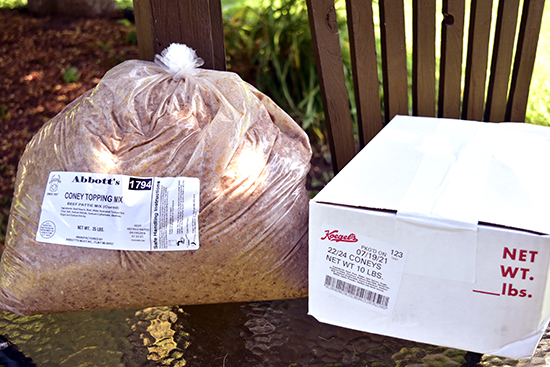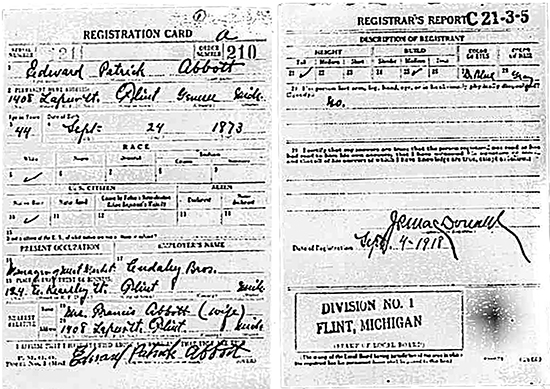
For a basic Flint Coney Sauce in Abbott’s style, visit: https://www.flintconeys.com/basic-flint-coney-sauce/
With the announcement on July 15, 2025, that Abbott Meats in Flint, Michigan, would shut down by the end of the year, came the realization that most people reacting to the announcement didn’t know the real history of the meatpacker. It was known that the meatpacker had begun operation in 1907, 118 years prior to that announcement. But the real story was certainly unknown. This is that story.
Beginnings in Wisconsin
Edward Abbott married Frances Josephine McMahon on June 7, 1904, and apparently relocated to Waukesha. (ii) Records don’t indicate why he ultimately moved to Flint, but there are two distinct possibilities. Suppliers and other people passing through Wisconsin were already talking about the manufacturing opportunities in Michigan, along with the need for other industries and services in those manufacturing areas. Some folks were relocating because of this information alone. (iii) But another possibility is that it was a business move.
Cudahy Packing

Regardless of why the move to Flint occurred, Edward and Frances showed up on the Genesee County census of 1910. (vi) The Cudahy Meat Outlet in Flint, aka the People’s Cash Meat Market, had apparently opened in 1907. According to his World War I draft registration card, the shop was still owned by the Cudahys when Edward signed that card on September 4, 1918. (vii) Cudahy Bros. still operated ninety-five of its own meat outlets in 1922, so the change to Abbott’s Meat was certainly after that date. Abbott’s still uses 1907 as its founding year in marketing, but that’s not exactly what occurred.
Cudahy Packing

Regardless of why the move to Flint occurred, Edward and Frances showed up on the Genesee County census of 1910. (vi) The Cudahy Meat Outlet in Flint, aka the People’s Cash Meat Market, had apparently opened in 1907. According to his World War I draft registration card, the shop was still owned by the Cudahys when Edward signed that card on September 4, 1918. (vii) Cudahy Bros. still operated ninety-five of its own meat outlets in 1922, so the change to Abbott’s Meat was certainly after that date. Abbott’s still uses 1907 as its founding year in marketing, but that’s not exactly what occurred.
Peoples' Cash Meat Market
The history of meat markets leading up to the naming of Abbott’s Meat from the People’s Cash Meat Market covers multiple names and addresses. People’s Cash Meat Market had originally opened at 124 East Kearsley Street in 1907, with Edward Abbott as its manager. An advertisement in the Flint Journal on January 17, 1919, announced the opening of a second location at 618 S. Saginaw St. By late 1925 a Tom Wolcott was included in Abbott’s advertising as a partner in the business. But on December 8, 1925, an announcement in the Flint Journal stated:
We wish to state that John Laux, formerly of 129 East Kearsley Street [a Hamady Bros. location] is now manager of the Peoples’ Cash Meat Market, 618 S. Saginaw St. Will appreciate having his past patrons patronize him at his new location.
Notice: I have purchased the interest of E.P. Abbott in the firm of Wolcott & Abbott. I wish to take this opportunity to express my sincere thanks for the generous patronage given the old firm, and hope to merit your continued goodwill and patronage in the future. This change will enable us to cut our cost considerably, which will mean a great savings to our customers. Watch for our Saturday Specials in our Friday Market Basket. [a feature of the Flint Journal] T.W. Wolcott, successor to Wolcott & Abbott, 124 East Kearsley St.
Abbott Meats & Their "Coney Topping Mix"
What seems to have been lost in public perception of the history of the Flint Coney is that Abbott’s Meat didn’t make a complete sauce for Brayan’s or any other restaurant until just before the turn of the twenty-first century. (The completed retail version Abbott’s offers today in four- and ten-pound bags is quite a recent development.) In speaking with me about his own history at Starlite Coney Island beginning in 1973, in early 2015 David Gillie of Gillie’s Coney Island told me, “They used the twenty-five-pound raw extra-fine grind of ‘beef heart, beef and soy texture’ from Abbott’s Meat.” Abbott’s provided the raw, unfrozen and unspiced sauce base to the restaurants, nothing more.


Many of the early Coney operators began their working lives at Brayan’s Flint Coney Island, taking the recipe and their own modifications with them to start their own Coney Islands, while passing on that knowledge to future operators as well. This traceable “pedigree” explains why every Flint Coney restaurant has its own distinct variation and its own followers who are accustomed to that specific flavor and texture, while still maintaining the Flint Coney “style.”
Once he was settled in Flint some time after 1921, Simion Brayan spoke with an Abbott’s Meat employee about his concept of using Macedonian goulash containing beef heart and kidney as the basis for his Flint Coney sauce. (x) It’s likely that his own recipe for Flint Coney sauce was never written down. At the time of the development of the sauce, home cooks generally didn’t write down their recipes. Any documentation of Brayan’s original recipe itself may not have ever existed.
The latter part of the 1930s turned out to be a banner time for the Flint Coney itself—though not so much for Flint Coney Island. Other owners of shoeshine parlors followed the lead of Brayan’s earliest competitors, and the popularity of the Flint Coneys grew. In the downtown area alone, there were seven Coney Islands by the late 1930s, compared to zero in 1925. (xi)
Various Flint telephone directories indicate the locations of Abbott’s retail stores in Genesee County over the years:
- 3848 Lapeer Rd.
- G3336 S. Dort Hwy.
- 1323 E. Bristol Rd.
Specific opening and closing dates for these locations are unknown.
Then, in an unexpected announcement on July 15, 2025, Ed Abbott revealed that the business his grandfather Edward had begun would only run intil the end of the year, and then would be shut down. “It’s been a little bittersweet and not a decision that he came to lightly and you know, at the forefront of his mind were his employees, his longtime employees and also his customers, who he cares about very much so this was not an easy decision to make,” said Jenny Abbott Bade, Abbott’s daughter. (xiii)
For the Die Hard Flint Coney folks like myself, compare the ingredients of this new Koegel’s product to Abbott’s similar product. Just as there are differences between the sauces of various Flint Coney restaurants, there will obviously be minor differences between Abbott’s completed sauce and this new Koegel’s version. (Note: The 25lb bag of unspiced base Abbott’s has shipped to restaurants to make their own sauce their way isn’t included here.
Koegel’s Pre-Spiced Coney Island Topping
Made with beef hearts and textured vegetable protein
Ingredients: Beef Heart, Beef, Water, Textured Vegetable Protein (soy flour, caramel coloring (contains sulfites)), Sodium Citrate, Sugar, Paprika, Salt, Sodium Diacetate, Garlic Powder, Chili Powder, Onion Powder, Cumin, Sodium Erythorbate, Sodium Nitrite.
Abbott’s Ready To Cook Coney Island Topping; Beef Pattie Mix (Cured), 4 or 10 lbs
Ingredients: Beef Hearts, Beef, Water Hydrated Textured Soy Flour, Onions, Spices, Salt, Monosodium Glutamate, Sodium Nitrate, Garlic Powder, Sodium Erythorbate, Dextrose, Sugar and Sodium Nitrite.
Notes & Bibliography
Notes
i. Martyn, “Patrick Edward Abbott [234].”
ii. Ibid.
iii. Bald, Michigan in Four Centuries.
iv. Cudahy Historical Society, “History of Cudahy.”
v. Martyn, “Patrick Edward Abbott [234].”
vi. Ibid.
vii. Ibid.
viii. Florine, Davison and Jeager, Two to Go.
ix. Kreuger, “Flint’s haute cuisine is the Coney Island.”
x. Ibid.
xi. Florine, Davison and Jeager, Two to Go.
xii. Bayerl, “Life and Family of Johann and Anna Maria Bayerl.”
xiii. Omair, Zane, “Meat supplier for Flint Coney Sauce shutting down”
Bibliography
- Bald, Dr. F. Clever. Michigan in Four Centuries. New York: Harper & Company, 1954.
- Bayerl, Andy. “The Life and Family of Johann and Anna Maria Bayerl.” Bayerl Family Home Page. https://www.bo-hemian.org/documents/Johann%20and%20Anna%20Marie%20Bayerl.pdf
- Cudahy Historical Society. “The History of Cudahy, Wisconsin.” https://www.cudahyhistoricalsociety.org/cudahy-history
- Florine, Bob, Matt Davison and Sally Jaeger. Two to Go: A Short History of Flint’s Coney Island Restaurants. Flint, MI: Genesee County Historical Society, 2007.
- Krueger, Ron. “Flint’s haute cuisine is the Coney Island,” Flint Journal, March 5, 1978.
- Martyn, Scott H. “Patrick Edward Abbott [234].” Martyn Family History. http://familyhistory.themartyns.net/familyfiles/234.htm.
- Omair, Zane. “Meat supplier for Flint Coney Sauce shutting down.” Wnem.com, July 15, 2025. https://www.wnem.com/2025/07/15/meat-supplier-flint-coney-sauce-shutting-down/
